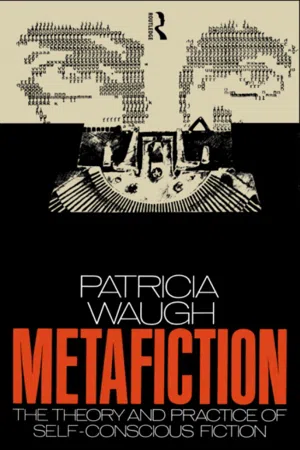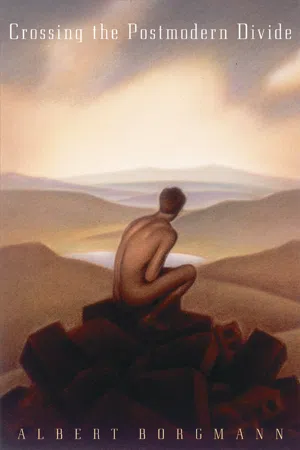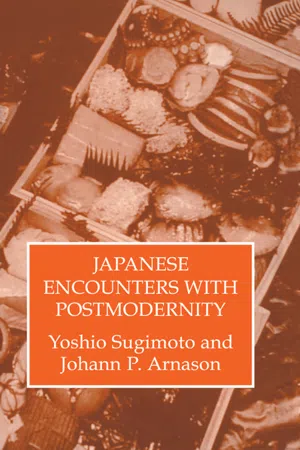Hypermodernism
Hypermodernism in literature refers to a movement characterized by a self-aware, reflexive approach to storytelling that challenges traditional narrative structures and conventions. It often incorporates elements of postmodernism while pushing boundaries further, embracing new technologies, and exploring the impact of globalization and digital culture on the human experience. Hypermodernist literature reflects a heightened awareness of the complexities of contemporary society.
8 Key excerpts on "Hypermodernism"
- eBook - ePub
Cultural Studies
Theory and Practice
- Chris Barker, Emma A. Jane(Authors)
- 2016(Publication Date)
- SAGE Publications Ltd(Publisher)
...6 Enter Postmodernism Key Concepts Enlightenment Grand narrative Hyperreality Irony Modernism Modernity Postmodernism Postmodernity Post-postmodernism Reflexivity The proliferation of books on the subject of postmodernism is not simply an academic fashion. It is also a significant response to substantive changes in the organization and enactment of our social worlds. In other words, there are material grounds for taking these debates seriously. Much of the primary theoretical work on postmodernism has been produced by writers with no direct affiliation to cultural studies as a ‘discipline’. Nevertheless, the debates and conceptual maps that developed as postmodernism emerged have been filtered into cultural studies. They form the context in which contemporary cultural studies has been developing and permeate the ‘sites’ of cultural studies investigations (Chapters 7 – 14). The postmodern influence in cultural studies underscores a certain break with its Marxist legacy. Defining the Terms Postmodern theory makes little sense outside of the associated concepts of modernity and modernism. Unfortunately, there is no consensus about what the pertinent concepts mean. For our purposes here: Modernity and postmodernity are terms that refer to historical and sociological configurations. Modernism and postmodernism are cultural and epistemological concepts. In particular, the concepts of modernism and postmodernism concern: cultural formations and cultural experience, for example, modernism as the cultural experience of modernity and postmodernism as a cultural sensibility associated with high or post-modernity; artistic and architectural styles and movements, that is, modernism as a style of architecture (Le Corbusier) or writing (James Joyce, Franz Kafka, Bertolt Brecht) and postmodernism in film (Blue Velvet, Blade Runner), photography (Cindy Sherman) or the novel (E.L...
- eBook - ePub
Metafiction
The Theory and Practice of Self-Conscious Fiction
- Patricia Waugh(Author)
- 2002(Publication Date)
- Routledge(Publisher)
...The existence of an unprecedented cultural pluralism has meant that post-modernist writers are not confronted with the same clear-cut oppositions as modernist writers were. An innovation in a literary form cannot establish itself as a new direction unless a sense of shared aims and objectives develops among experimental writers. This has been slow to take shape in recent years. An argument originally advanced by Lionel Trilling in Beyond Culture (Trilling 1966) and reiterated by Gerald Graff has suggested one reason for this: that the unmasking of the ‘hypocritical bourgeois belief in the material and moral progress of civilization’ (Graff 1975, p. 308) has been so thoroughly accomplished by modernism that the creative tension produced by opposing this ‘bourgeois belief’ is no longer clearly available the novelist. In eighteenth- and nineteenth-century fiction, the individual is always finally integrated into the social structure (usually through family relationships, marriage, birth or the ultimate dissolution of death). In modernist fiction the struggle for personal autonomy can be continued only through opposition to existing social institutions and conventions. This struggle necessarily involves individual alienation and often ends with mental dissolution. The power structures of contemporary society are, however, more diverse and more effectively concealed or mystified, creating greater problems for the post-modernist novelist in identifying and then representing the object of ‘opposition’. Metafictional writers have found a solution to this by turning inwards to their own medium of expression, in order to examine the relationship between fictional form and social reality. They have come to focus on the notion that ‘everyday’ language endorses and sustains such power structures through a continuous process of naturalization whereby forms of oppression are constructed in apparently ‘innocent’ representations...
- eBook - ePub
- Albert Borgmann(Author)
- 2013(Publication Date)
- University of Chicago Press(Publisher)
...In its inchoate phase, it already exhibits two distinct tendencies. The first is to refine technology. Here postmodernism shares with modernism an unreserved allegiance to technology, but it differs from modernism in giving technology a hyperfine and hypercomplex design. This tendency I call Hypermodernism. The alternative tendency is to outgrow technology as a way of life and to put it in the service of reality, of the things that command our respect and grace our life. This I call postmodern realism. Hypermodernism tends to produce hypertrophic versions of the three developments that are distinctive of the postmodern economy—information processing, flexible specialization, and informed cooperation. Of course, hypermodern tendencies are also visible in the intellectual debate and in architecture, but the former is not constructive enough and the latter is too solid to exhibit Hypermodernism clearly. Once we recognize the hypermodern design in the economy, we can discover its spell among the intellectuals and architects, too. Information processing attains its hypermodern exaggeration to the extent that it overcomes and displaces tangible reality. Even in its hypertrophic state, it continues to be patterned by technology and preserves the division of the realm of labor from the realm of leisure. The hypermodern modification of the former constitutes at first a painful and disorienting process. Workers who are accustomed to a tangible, audible, pungent, and spacious setting find it hard to gain entry, by way of monitor and keyboard, into the unreal world of computerized information. Zuboff has us listen to the anguished testimony of a pulp mill operator. “With computerization I am further away from my job than I have ever been before. I used to listen to the sounds the boiler makes and know just how it was running. I could look at the fire in the furnace and tell by its color how it was burning. I knew what kinds of adjustments were needed by the shades of color I saw...
- eBook - ePub
Transcending the Postmodern
The Singular Response of Literature to the Transmodern Paradigm
- Susana Onega, Jean-Michel Ganteau, Susana Onega, Jean-Michel Ganteau(Authors)
- 2020(Publication Date)
- Routledge(Publisher)
...As Jean-Françoi s Lyotard famously argued in The Postmodern Condition (1979), these decades witnessed a shift in worldview characterised by a generalised loss of faith in humanist values and the widespread demands for engagement and commitment by the new pacifist, anti-militarist, feminist and “green” political options then emerging. These new ideological positions, with their critique of totalising “grand narratives” – those forms of imaginative invention built in terms of linear progress towards emancipation – opened up new spaces for the expression of the fragmentary and competing ideologies of the political, sexual, ethnical and religious margins of society in the form of petits récits (60), little narratives capable of offering heterogeneous and diverse perspectives on the (traumatic) stories of the religious, sexual and ethnic minorities forced into silence or erasure by the dominant discourse. This shift from Modernity to Postmodernity was yet again accompanied by the birth of a new literary genre, in this case, historiographic metafiction, a type of novel built on the paradoxical combination of self-reflexivity and the levelling of history and literature to the same status of human construct (Hutcheon). The postmodernist rejection of Hegelian World History as a grand universal narrative of explanation had an undoubted ethical and political value as it facilitated the rise of marginal voices and the rediscovery of oppressed pasts, like the Jewish memory of the Holocaust or the revelation of the horrors endured by African slaves during the “Middle Passage.” However, certain voices have attacked the very foundation of subaltern “counter histories” as being none other than identity politics, fostering the definition of human identity in exclusive and separatist categories and privileging cultural identities over socio- political ones...
- eBook - ePub
Reading Between the Lines
A Christian Guide to Literature
- Gene Edward Veith Jr.(Author)
- 2013(Publication Date)
- Crossway(Publisher)
...Disdaining elitism, the Postmodern movement reaches out to the popular culture. Postmodernism refuses to take itself too seriously, which is healthy in any literary movement; the problem is that it sometimes fails to take anything seriously. Acutely aware of the decline of religion, Matthew Arnold offered literature as a substitute. “Most of what now passes with us for reli gion and philosophy will be replaced by poetry.” As a result, “More and more, mankind will discover that we have to turn to poetry to interpret life for us, to console us, to sustain us.” 13 Many people today do turn to literature or other works of art for a sense of meaning, an experience of transcendence, and guidance for their lives. In literary criticism, religious language has been displaced into the realm of literature. Critics speak of the author’s “inspiration.” They argue over principles of correctly interpreting the text, speaking of “hermeneutics,” a term originally used for the techniques of interpret ing Scripture. They debate over what works should be included in the “canon,” a term referring to the list of inspired books that constitute the Bible. In effect, this has meant that all literature is treated as Scripture...
- eBook - ePub
- Yoshio Sugimoto, ohann P. Arnason(Authors)
- 2012(Publication Date)
- Routledge(Publisher)
...One Japanese critic has pointed to the increasing tendency of writers in Japan today to abandon the effort to resist the existing system of representation. 40 Another critic has questioned why Japanese writers have so thoroughly lost the capacity to address the question of negativity. 41 Murakami’s name was mentioned by both. And yet, the undeniable fact is that Murakami’s works have attracted a remarkable following, which suggests that the general readership in contemporary Japan is willing to endorse the sentiment and the sensibility expressed in his writing. Are they reading it as a ‘background novel’ as they would enjoy harmless, nonengaging background music, as one critic cynically put it? 42 In contemporary Japan, the critical faculties on the part of both writers and readers are put to question. As Ōe mentioned in the paper quoted above, it is indisputable that modernist literature as fundamentally oppositional art is in decline. 43 The shock of the new, characteristically defined in modernist literature as the experience of estranging oneself from the familiar world and establishing a critical distance, no longer seems to work in a society in which everything, or anything, can become a purchasable commodity. As Eysteinsson illustrates in the context of the modernism/postmodernism debate in the West, in a society where commercialism pervades, ‘shock’ ultimately becomes affirmative. The intended shock effect of TV commercials is one such example; or in the case of punk, ‘the material objects that the radical practices of punk had sought to empty of meaning are again turned into marketable commodities’. 44 In contrast to the oppositional, and therefore exclusionist, character of modernism, postmodernism in theory aims at radical decentralisation. Furthermore, the elitist aspect of modernism associated with high culture is negated by postmodernism, which claims to break down cultural hierarchy...
- eBook - ePub
Theory in Social and Cultural Anthropology
An Encyclopedia
- R. Jon McGee, Richard L. Warms(Authors)
- 2013(Publication Date)
- SAGE Publications, Inc(Publisher)
...Scott A. Lukas Scott A. Lukas Postmodernism Postmodernism 639 645 Postmodernism Postmodernism is a controversial philosophical, aesthetic, and cultural formation that has influenced culture, literature, art, and the social sciences, including anthropology. Foundations Postmodernity generally refers to a period beginning in the 1980s (sometimes also referred to as late capitalism) in which radical changes in technology, economics, politics, architecture, and popular culture signified a shift in society—a movement away from modernity. Some thinkers, including Daniel Bell, have denoted this period as a time of postindustrialism. Massive changes in the nature of economics (e.g., the movement toward multinational corporations), transformations in government, alterations in technology and information systems, the development of a media-based society, and changes in consumerism can all be attributed to this epochal shift that has been labeled postmodernity. In a cultural sense, postmodernity often refers to a period in society in which hyperreality and cultural eclecticism are the norms...
- Theo D'haen(Author)
- 2013(Publication Date)
- Routledge(Publisher)
...Such “cultures of postcolonial contra-modernity,” he contends, “may be contingent to modernity, discontinuous or in connection with it, resistant to its oppressive, assimilationist technologies” (Bhabha 1994: 6). At the same time, he maintains, “they also deploy the cultural hybridity of their borderline conditions to ‘translate’, and therefore re-inscribe, the social imaginary of both metropolis and modernity” (Bhabha 1994: 6). Elsewhere (D’haen 1994), I have proposed the term “counter-postmodernism” to indicate the same relationship between metropolis, postcolonialism, and modernity, or, more precisely perhaps, to indicate how postmodernism and postcolonialism, the latter together with its twin multiculturalism, “shadow” postmodernism within the more general framework of modernity. Aijaz Ahmad I think intimated very much the same thing when in 1992, still using the earlier term “third-world literature,” he proposed that: “There now appears to be, in the work of the metropolitan critical avant-garde, an increasing tie between postmodernism and the counter-canon of ‘Third World Literature’” (Ahmad 1992: 125). Hans Bertens (1991), contextualizing the debate on postmodernism around 1990, distinguishes an “avant-garde,” a “poststructuralist” and an “aesthetic” postmodernism, and links these various postmodernisms both to different historical stages in the use of the term, roughly speaking the 1960s, 1970s and 1980s, and to different stances, inspired by opposing socio-political convictions, toward contemporary literature and culture in general. These stances, moreover, are perceptually defined. In other words, they depend upon how one reads a particular work rather than upon any “objective” quality of the work itself. An avant-garde reading, primarily associated with Ihab Hassan (1982 [1971], 1975, 1980, and 1987) and Douwe Fokkema (1984 and 1986), foregrounds the work’s technical features distinguishing it from works in a previous mode, and specifically from modernism...







